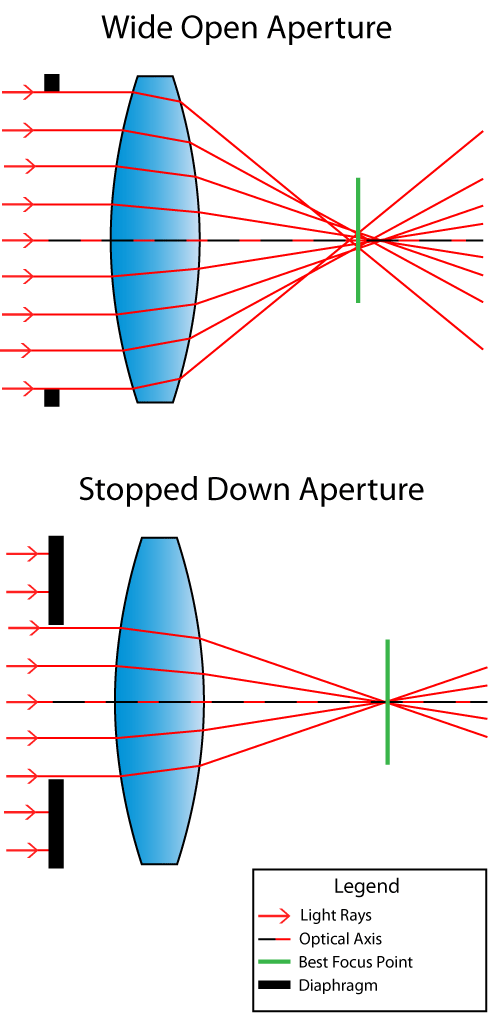Focus Shift is an optical problem that occurs due to Spherical Aberration, when an object is brought into focus at maximum aperture and captured with the lens stopped down. Focus shift can lead to blurry images and focus errors, when working with subjects at close distances and using fast aperture lenses. With the lens aperture fully open or “wide open”, incoming rays of light converge at different focal points due to spherical aberration along the optical axis, as shown in the top illustration below:

When the lens is stopped down (the size of the aperture is decreased), light rays no longer reach the edge or the “periphery” of the lens and only the ones close to the optical axis make it through. As a result, the point of best focus with the circle of least confusion is moved to the right, as shown in the second illustration above. If focus is not re-adjusted after this change of aperture, it will shift the sharpest focus plane (hence the name “focus shift”) away from the lens, essentially moving it slightly behind the focused area. Imagine focusing on an eye, only to find out later that you ended up with a nose in focus instead, just because you changed camera aperture.
Focus Shift and Fast Aperture Lenses
Most lenses prone to focus shift problems have very fast maximum apertures of f/1.0, f/1.2 and f/1.4 for one major reason – a big portion of the lens surface is used to transmit the light. Fast prime lenses with uncorrected spherical aberration will always have focus shift problems for this reason. In fact, any fast lens with spherical aberration problems will exhibit focus shift at different apertures. Slower lenses with maximum aperture of f/1.8 and smaller that also suffer from spherical aberration problems will have a much less pronounced focus shift, so it will not be as noticeable in images.
Phase Detect AF Problem
What many photographers do not know, is that their AF lenses are always set to the maximum aperture when phase detection autofocus is used. The reason for this, is that phase detection uses two small sensors to measure AF accuracy (depending on the angle of light) and they require a lot of light to work effectively, which is why lens aperture stays wide open even when the lens is stopped down on the camera. The aperture changes only when you finally press the shutter button and opens back up at the end of the exposure. At smaller apertures, the light comes at a much smaller angle, making it harder for the AF sensors to see if the subject is in focus or not. On top of that, there is much less incoming light for the sensors to see much contrast, which also causes autofocus accuracy issues. These are the main reasons why camera manufacturers claim that autofocus does not work on lenses slower than f/5.6-f/8 (on the latest Nikon DSLRs). Interestingly, the most optimal lenses for the phase detect AF system are the ones that have a maximum aperture between f/2.0 and f/4.0. Large-aperture prime lenses with maximum aperture larger than f/2.0 have a very small depth of field, so they just take longer to obtain correct focus.
Why is this all important and what does phase detect AF have to do with the focus shift? As shown in the illustration above, focus shifts to the right (or away from the camera) when aperture is changed. Since phase detect AF leaves the lens aperture wide open while autofocusing, the sharpest focus plane is going to shift when you take a picture with the lens stopped down. This is potentially a big problem, because it means that you might not be able to achieve correct focus, unless you stop down enough to compensate the shift (by increasing depth of field). Sadly, even the AF Fine Tune function in some advanced cameras like Nikon D7000 is not going to help, because it does not allow micro-adjusting focus for different apertures. If you adjust focus for a lens at f/2.8, focus will certainly shift at f/1.4 and vice-versa.
Focus Shift: Phase Detect vs Contrast Detect
Contrast Detect (Live View) AF System, on the other hand, does not have these problems on advanced DSLRs that allow changing aperture in Live View mode. Since Live View shows everything through the lens and adjusts the lens focus based on image contrast, changing aperture and then refocusing will provide correct focus – that’s because aperture will actually change on the lens in contrast detect mode. Some entry-level DSLRs do not provide the ability to change aperture in Live View mode, which would again result in focus shift when changing lens aperture.
Reducing Focus Shift
As you can see from this article, focus shift can be a very problematic and annoying issue on fast aperture prime lenses. While there are some tricks you can employ to reduce or get rid of focus shift, most of them are unpractical. Unless camera manufacturers provide the ability to fine tune autofocus on each aperture, there is no easy way to deal with this problem. Unless, of course, manufacturers design lenses with aspherical elements to reduce spherical aberration and focus shift problems; or incorporate focus shift data into camera firmware, which will automatically adjust focus based on a lens and its aperture. Anyway, here is the list of tricks or workarounds to reduce focus shift:
- Use maximum aperture – take pictures at the maximum aperture and you won’t have to worry about focus shift. Might not be practical for most lenses, because they are soft wide open. See the next bullet point for an alternative solution.
- AF Fine Tune optimal aperture – if your camera has the ability to fine tune autofocus, set your lens to its optimal aperture that you will be primarily using, then fine tune autofocus. You will then have to shoot at this optimized aperture all the time and stop down when needed. Using larger apertures will result in focus errors after this type of calibration.
- Use a slower lens – if you want to avoid focus shift problems, use slower f/1.8-f/2.8 lenses that have much less issues with focus shift.
- Stop down the lens – usually stopping down the lens to apertures smaller than f/2.8 will take care of the focus shift problem due to increased depth of field. Not very practical for fast aperture lenses, but will certainly take care of the problem.
- Use Contrast Detect AF – not practical for most situations, because Contrast Detect AF is slow and requires the mirror to be raised up, blocking the viewfinder.
- Use Manual Focus Lenses with Aperture Rings – a manual focus lens with an aperture ring will allow you to control the aperture from the lens, so you can stop it down before manually acquiring focus. You will have to reacquire focus every time you change aperture though.
If you are interested in reading more, below is the list of articles on other types of aberrations and issues that we have previously published on The Photographers:




